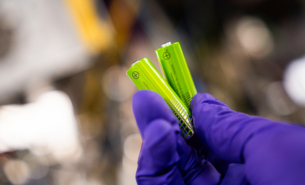In a new publication in Nature Communications, a team from the Dutch company Syngaschem BV and the Dutch Institute for Fundamental Energy Research elucidates for the first time some aspects of the Fischer-Tropsch reaction, used for converting synthesis gas into synthetic fuels. Analysis performed at the HIPPIE beamline at MAX IV was instrumental to achieving these results.
The adoption of sustainable and renewable energy sources to permanently move beyond the dependence on fossil fuels constitutes one of the great challenges of our time. One that is made more urgent by the effects of climate change we witness on a daily basis. Electrification, such as we see in the development of electric vehicles, seems a promising strategy, but it cannot be the solution for all applications. In many cases, liquid fuels are still considered the best and most efficient option. Is there a way to produce liquid fuels in an efficient and sustainable manner, one that does not rely on fossil sources?
Syngas and synthetic fuels
The research company Syngaschem BV believes that synthetic fuels can be the key to developing non-fossil fuels for industrial use. A team of researchers from Syngaschem BV and the Dutch Institute for Fundamental Energy Research (DIFFER) came to MAX IV at HIPPIE beamline to elucidate some aspects of a complex reaction called Fischer-Tropsch, used to produce synthetic fuels. They discovered insights on how important intermediates are stabilised during the reaction, and the study has now been published in Nature Communications.
Syngaschem BV, based in The Netherlands, is specialises in fundamental research in catalysis and surface chemistry. They focus on synthetic fuels, considered a promising alternative that can potentially replace traditional liquid fossil fuels while retaining the efficiency and energy density needed in industrial applications.
The production of synthetic fuels is based on syngas (synthesis gas) as the main intermediate. Syngas is a mixture of carbon monoxide and hydrogen produced from different sources including natural gas, coal, biomass, and renewable energies. Starting from syngas and other intermediates, synthetic fuels can be produced through the Fischer-Tropsch reaction. During the reaction, syngas is used to produce long hydrocarbon chains that represent the base of the liquid synthetic fuel.
Elucidating the elusive Fischer-Tropsch reaction
“The mechanism of the Fischer-Tropsch reaction in which synthesis gas is converted into long-chain hydrocarbons is very complex and continues to be debated”, explains Dr. Kees-Jan Weststrate, Senior Research Scientist at Syngaschem BV. “By studying how hydrocarbons react on a model catalyst surface we aim to better understand which reactions are happening on the catalyst and elucidate the reaction mechanism.”
Indeed, observing the Fischer-Tropsch reaction is a considerably difficult effort, and it is basically impossible to identify the reaction intermediates. Experimental information is almost entirely indirect, and the proposed reaction mechanism often relies on theoretical models. A better understanding of how the reaction unfolds could hopefully help improve its efficiency.
Using a simplified model catalyst, a single crystal surface of cobalt, Dr. Weststrate and his team performed XPS (X-ray photoelectron spectroscopy) measurements that allowed them to identify the reactants involved in the formation of new C-C bonds and measure the kinetics of this reaction. The researchers proved that a high concentration of carbon monoxide (CO) during the reaction plays a crucial role. “The CO molecule does not react itself in the C-C bond-forming reaction but has an important stabilising effect on the intermediate that is required for the reaction. This makes it likely that the intermediates observed in our model system also participate in the reaction that produces long chains in applied catalysis.”

Experiments at MAX IV
At MAX IV using the HIPPIE beamline, the team performed Ambient Pressure X-ray Photoelectron Spectroscopy (APXPS) experiments and were pleased with the technology they found at the beamline. “We needed to switch quickly between APXPS (Ambient Pressure X-ray Photoelectron Spectroscopy) and UHV (ultra-high vacuum) conditions”, says Dr Weststrate. “The speed at which we could take the spectra was impressive owing to the high flux from the beamline. This allowed us to do time-resolved measurements at a speed that was fast enough to capture the chemistry we were interested in.” The team proved that the reaction intermediates are stable on the cobalt model’s surface. “Our experiments show that the intermediates we see are reactive for the formation of C-C bonds. The HIPPIE experiments show that they are also very stable in the sense that they do not leave the surface easily. The combination of the two makes them suitable intermediates for the growth of long chains.”
These fundamental insights open new avenues in understanding the Fischer-Tropsch reaction and improving its efficiency. An improved reaction coupled with the use of syngas produced from renewable sources will hopefully help turn synthetic fuels into a practical replacement of fossil ones, encouraging the move beyond fossil fuels and towards sustainable and renewable sources of energy.




